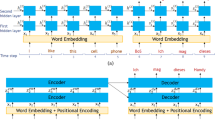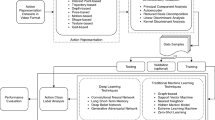Abstract
A novel method case-based reasoning was proposed for suspicious behavior recognition. The method is composed of three departs: human behavior decomposition, human behavior case representation and case-based reasoning. The new approach was proposed to decompose behavior into sub-behaviors that are easier to recognize using a saliency-based visual attention model. New representation of behavior was introduced, in which the sub-behavior and the associated time characteristic of sub-behavior were used to represent behavior case. In the process of case-based reasoning, apart from considering the similarity of basic sub-behaviors, order factor was proposed to measure the similarity of a time order among the sub-behaviors and span factor was used to measure the similarity of duration time of each sub-behavior, which makes the similarity calculations more rational and comprehensive. Experimental results show the effectiveness of the proposed method in comparison with other related works and can run in real-time for the recognition of suspicious behaviors.
Similar content being viewed by others
References
KULIC D, NAKAMURA Y. Incremental learning of human behaviors using hierarchical hidden Markov models [C]// IEEE International Conference on Intelligent Robots and Systems. Taipei: Intelligent Robots and Systems (IROS), 2010: 4649–4655.
ZHOU Han-ning, KIMBER D. Unusual event detection via multi-camera video mining [C]// 18th International Conference on Pattern Recognition. Hong Kong: CICPR, 2006: 1161–1166.
NAPHADE M R, HUANG T S. A probabilistic framework for semantic indexing and retrieval in video [C]// IEEE International Conference on Multimedia and Expo. New York: IEEE Press, 2000: 475–478.
NIU F, ABDEL-MOTTALEB M. HMM-based segmentation and recognition of human behaviors from video sequences [C]// IEEE International Conference on Multimedia and Expo. Amsterdam: IEEE Press, 2005: 804–807.
LI He-ping, HU Zhan-yi, WU Yi-hong, WU Fu-chao. Behavior modeling and abnormality detection based on semi-supervised learning method [J]. Journal of Software, 2007, 18(3): 527–537. (in Chinese)
ZHU Xu-dong, LIU Zhi-jing. Human abnormal behavior recognition based on topic hidden Markov mode [J]. Computer Science, 2012, 39(3): 251–275. (in Chinese)
XIANG T, GONG S G. Video behavior profiling and abnormality detection without manual labeling [C]// Proceedings of the IEEE International Conference on Computer Vision. Beijing: IEEE Press, 2005: 1238–1245.
ZHANG Jun, LIU Zhi-jing. A method of abnormal action recognition in variable scenarios [J]. Journal of Image and Graphics, 2009, 14(10): 2097–2101. (in Chinese)
BREGONZIO M, GONG S G, XIANG T. Recognizing action as clouds of space-time interest points [C]// IEEE Conference on Computer Vision and Pattern Recognition. Miami: IEEE Press, 2009: 1948–1955.
RYOO M S, AGGARWAL J K. Recognition of composite human behaviors through context-free grammar based representation [C]// IEEE Computer Society Conference on Computer Vision and Pattern Recognition. New York: IEEE Computer Society, 2006: 1709–1718.
ELHAMOD M. Automated real-time detection of potentially suspicious behavior in public transport area [J]. IEEE Transactions on Intelligent Transportation Systems, 2013, 14(2): 688–699.
ELHAMOD M, LEVINE M D. Real-time semantics-based detection of suspicious behaviors in public spaces [C]// 2012 Ninth Conference on Computer and Robot Vision. Toronto: IEEE Press, 2012: 268–275.
WILIEM A, MADASU V, BOLES W, YARCAGADDA P K. A context-based approach for detecting suspicious behaviors [C]// Digital Image Computing: Techniques and Applications. Melbourne: IEEE Press, 2009: 156–153.
XIA Li-min, HUANG Jin-xia, TAN Lun-zheng. Human action recognition based on chaotic invariants [J]. Journal of Central South University, 2013, 20(11): 3171–3179.
LAI Jie-ling, YI Yang. Key frame extraction based on visual attention model [J]. Journal of Visual Communication and Image Representation, 2012, 23(1): 114–125.
ITTI L, KOCH C. A saliency-based search mechanism for overt and covert shifts of visual attention [J]. Vision Research, 2000, 40(10/11/12): 1489–1506.
NIE Y, MA K H. Adaptive rood pattern search for fast block-matching motion estimation [J]. IEEE Transactions on Image Processing, 2002, 11(12): 1442–1449.
PARK S, AGGARWAL J K. Simultaneous tracking of multiple body parts of interacting persons [J]. Computer Vision and Image Understanding, 2006, 102(1): 1–21.
PARK S, AGGARWAL J K. Recognition of composite human behaviors through context-free grammar based representation [C]// 2006 IEEE Computer Society Conference on Computer Vision and Pattern Recognition. New York: IEEE Press, 2006: 1709–1718.
VLACHOS M, KOLLIOS G, GUNOPULOS D. Discovering similar multidimensional trajectories[C]// 18th International Conference on Data Engineering, San Jose: IEEE Computer Society, 2002: 673–684.
CAVIAR test case scenarios [EB/OL]. 2004-01-17. http://groups.inf.ed.ac.uk/vision/CAVIAR/CAVIADATA1/.
BEHAVE interactions test case scenarios [EB/OL]. 2007-10-05. http://groups.inf.ed.ac.uk/vision/BEHAVEDATA/INTERACTIONS/.
STEPHEN K, LORCAN C, SIMON D. Using ontologies in case-based behavior recognition [C]// Twenty-First International Artificial Intelligence Research Society Conference. Daytona: Association for the Advancement of Artificial Intelligence, 2010: 336–341.
WANG T, SNOUSSI H. Histograms of optical flow orientation for visual abnormal events detection [C]// 2012 IEEE Ninth International Conference on Advanced Video and Signal-Based Surveillance (AVSS). Beijing: IEEE Press, 2012: 13–18.
Author information
Authors and Affiliations
Corresponding author
Additional information
Foundation item: Project(50808025) supported by the National Natural Science Foundation of China; Project(2013GK3012) supported by the Science and Technology Project of Hunan Province, China
Rights and permissions
About this article
Cite this article
Xia, Lm., Yang, Bj. & Tu, Hb. Recognition of suspicious behavior using case-based reasoning. J. Cent. South Univ. 22, 241–250 (2015). https://doi.org/10.1007/s11771-015-2515-9
Received:
Accepted:
Published:
Issue Date:
DOI: https://doi.org/10.1007/s11771-015-2515-9




